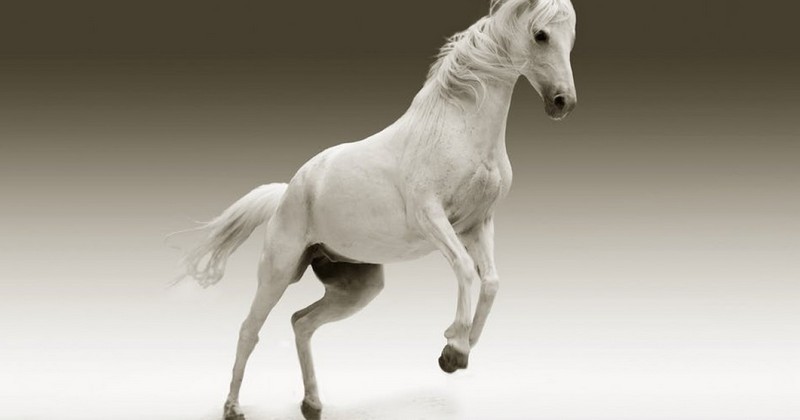Hypophobia (fear of horses): symptoms, causes and treatment

This anxiety disorder can produce attacks of intense fear towards these animals.
Horses have been a symbol of nobility, strength and loyalty for centuries. Throughout history and until the invention and popularization of the automobile, these animals have accompanied man in almost all his movements.
From ancient times to the present day, equines have been highly valued, admired and loved by the vast majority of people, even starring in the dreams of many children. But for some people, seeing or meeting a horse can be a cause of great discomfort and panic. This is what happens to people who suffer from hypophobia, an anxiety disorder related to horses.an anxiety disorder related to this type of animals.
What is hypophobia?
Hypophobia is the extreme and exaggerated fear or panic extreme and exaggerated fear or panic produced by the presence of horses.. This fear can appear before the presence of horses themselves or before the expectation of their appearance, although it can also appear (although generally to a lesser extent) before representations of these creatures.
It is a specific phobia referred to animals, which supposes the existence during at least six months of an exaggerated and disproportionate fear or panic in relation to the possible danger that the stimulus in question could suppose. The sufferer usually tends to avoid, or to endure with a very high level of anxiety, contact with these creatures. Previously it was considered that the person himself is usually aware that his reaction is exaggerated for the real danger involved, but today such recognition is not required to diagnose it.
The sight or mere thought of the proximity of a horse can cause a person with hypophobia to experience the onset of a very high level of anxiety that in fact can derive in a crisis of anguish. Sweating, trembling, headache, Nausea and vomiting are some of the most frequent physiological symptoms, together with tachycardia and hyperventilation.
Since it is not common to encounter horses in our daily lives, this phobia does not usually cause great interference in the sufferer's daily life. However, the fear can also be triggered in situations associated with the presence of horses or in which representations of these creatures appear, avoiding for example merry-go-rounds, amusement parks or fairs where such representations or even real animals may appear.
Causes of this phobia
Like other phobias, the causes of hypophobia are largely unknown. However, there are different hypotheses regarding its onset, there are different hypotheses regarding its onset.
The main hypothesis is that the fear of horses is acquired, learned from experience. It is usually suffered by people who have had accidents, whether they have kicked or fallen. It can also be learned vicariouslyIt can also be learned vicariously, either because someone in the environment has suffered accidents related to these beings or because it has been visualized or read cases of accidents related to equines.
Another of the most common hypotheses is the one that presents the phobia to certain stimuli as something partly phylogenetically inherited through genes, a natural reaction that allows the human being to escape from that allows the human being to escape from a dangerous stimulation. Although horses are herbivores that would not hunt us and would not pose a threat at first, they are animals of great power and size: the kick of a horse has the potential to be deadly, and a stampede of these creatures could easily cause the death of a person.
Treatment of fear of horses
As in the rest of phobias, one of the main and most effective treatments to apply for the treatment of the hypophobia is exposure therapy. This therapy is mainly based on exposing the subject to the feared stimulus without using avoidance techniques until the anxiety and panic caused by the phobic element diminish until they become practically imperceptible.
It is generally carried out in a graded manner: a hierarchy of phobic stimuli should be made.The first step would be to start with different items or stimuli that generate panic, ordered according to the level of anxiety they cause, and gradually expose the subject to these stimuli in a graded manner. For example, in the present case, it could start with exposure to images of equines to gradually increase the complexity and level of exposure, such as visiting and riding on merry-go-rounds, exposure to the sight of a live equine and gradually approaching it, perhaps to the point of touching or even riding on the animal.
In the long run, even a visit to a stable or even the practice of equine therapy can be considered. However, this is just an example: the items to be considered must be negotiated between patient and therapist depending on what the patient is anxious about (something that can vary greatly from patient to patient, even if the phobic stimulus is the same) and what he/she is willing to do.
Beyond exposure, cognitive restructuring can be of great help in combating distorted and maladaptive beliefs, such as a possible view that approaching a horse will cause it to be hostile, that horses are aggressive, that the and maladaptive beliefs, such as a possible view that approaching a horse will cause it to be hostile, that horses are aggressive, that the subject is unable to cope with his panic, or that he is likely to fall off a horse if he gets on it.
The use of relaxation techniques can be helpful in the face of anxiety, whether it is to prepare for a possible exposure or to reduce the internal tension associated with their panic.
(Updated at Apr 12 / 2024)